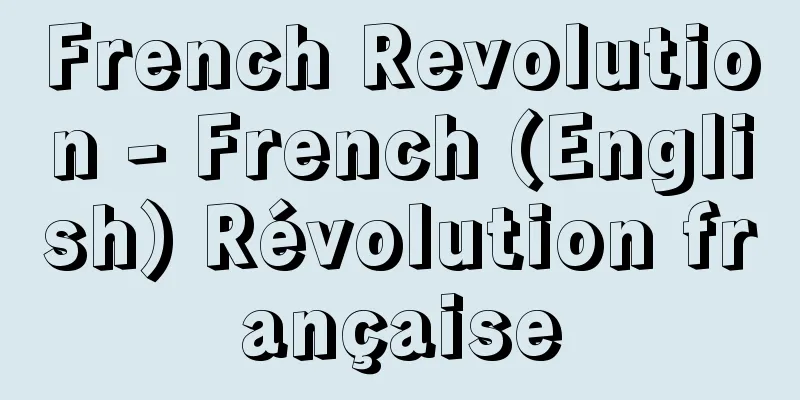French Revolution - French (English) Révolution française

|
The French Revolution was a revolution that took place in France between July 14, 1789 and November 9, 1799 (18 Brumaire, Year 8 of the Republican calendar). Significance of the RevolutionThis revolution covered all areas of thought, law, politics, and society, and, armed with the idea of natural rights, it destroyed the legal structure of absolute monarchy and built a bourgeois society based on private ownership. In the process, various classes participated in the revolution in parallel, so it is said to be a typical civil revolution, but in the end, it recognized the freedom of domestic commerce and industry and the freedom to cultivate land. At the start of the revolution, it rejected wars between absolutist nations, but midway through, intervention wars began with Austria, Prussia, and others, and then Britain entered the war. Under this pressure, the situation developed rapidly, and political instability continued, and it was finally put to rest by Napoleon's coup d'état, backed by the military. This reflects the historical environment in which the French Revolution took place, reflecting the fact that France was a less developed country than Britain, but a more advanced capitalist country than other countries on the continent. [Akira Okamoto] backgroundThe ideas of the revolution were cultivated by the ideas of the Enlightenment from the mid-18th century. Among them, Montesquieu advocated the distinction and organic union of the three powers, idealized a monarchy that made use of the aristocracy, and criticized the absolutism of Louis XIV. Voltaire condemned religious fanaticism and advocated tolerance, Quesnay advocated the transformation into a landlord state under an enlightened monarchical despotism, and Diderot recognized the inherent happiness of human beings in the satisfaction of desires. Finally, Rousseau, starting from a fierce criticism of civilization, envisioned a people's state in which individuals would receive equal public rights in exchange for transferring their personalities and ownership rights by contract. The absolute monarchy that was the target of these various criticisms was based on a class-based society and granted tax exemptions to monks and aristocrats, who made up only 2% of the country's 25 million citizens. These privileged classes lived off the taxes paid by the Third Estate, especially the peasants who made up 85% of the population, and as feudal lords, collected land rents while living at court or in the provinces. The government of Louis XVI (reigned 1774-1792) was in financial difficulty due to the accumulated deficits and military expenses for supporting the American Revolution. For this reason, the Inspector General of Finances, Calonne, was forced to convene a meeting of notables in February 1787 (some historians consider this period to be the beginning of the revolution). He proposed a "subsidiary land tax" to tax the privileged classes, but this was strongly opposed by the monks and nobles, and the High Court, which had the power to review royal decrees, conspired to overthrow Calonne. Similarly, the tax and judicial reforms of Brienne, the president of the Council of Finances, and Lamoignon, the Minister of the Great Seal, also failed, and Necker was appointed Minister of Finance again in August 1788. He tried to overcome the financial crisis by borrowing the financial resources of the Third Estate, and responded to the request of the High Court to convene the Three Estates General (État Générois) and decided to double the number of Third Estate representatives. [Akira Okamoto] The course of the revolutionFrom the Estates-General to the National AssemblyThe Three Estates General met at the Palace of Versailles on May 5, 1789. There were 300 clergymen and 300 noblemen, and about 600 from the Third Estate. Sieyès and other Third Estate deputies insisted on joint discussions, and some of the clergymen agreed, declaring the National Assembly on June 17. Liberal nobles such as La Fayette also joined, and it was officially approved at the end of the same month. The National Assembly began work on drafting a constitution in early July, but the Count of Artois and other conservatives at the court put pressure on the King and massed troops near Versailles, causing extreme anxiety among the citizens of Paris. [Akira Okamoto] Storming of the BastilleOn July 11, 1789, King Louis XVI dismissed Necker as the man responsible for the situation. When news of this reached Paris, the citizens were enraged, and on the 14th of that month, about 10,000 people attacked the Bastille prison, where political prisoners were held, with the Royal Guard joining in and occupying it. The next day, the last mayor of Paris under the old regime, de Fressel, and the commander of the garrison, de Launay, were killed, thwarting the court's plan. Paris moved towards the establishment of an autonomous system, and the Electoral Assembly appointed mayor Bailly and commander-in-chief of the National Guard, La Fayette. [Akira Okamoto] Abolition of feudal privileges and the Declaration of the Rights of ManIn the provinces, violent peasant unrest broke out, as if responding to the movement in Paris. As early as the mid-18th century, the feudal lords had been collecting overdue land rents and revising the land register at the peasant's expense, which had caused resentment from the peasants. At this time, the peasants, frightened by rumors of a "conspiracy by the nobles" that bandits were being unleashed on the countryside, attacked the feudal lord's castle and set fire to the land register. Against the backdrop of these unrests, on the night of August 4, 1789, the Constituent Assembly, at the suggestion of Viscount Noailles, declared the abolition of feudal privileges and the seigneurial system, realizing the prerequisite for equality before the law. However, in March 1790, the feudal rights associated with the status of serfs were abolished free of charge, but the feudal rights over land, i.e. the seigneurial rent, were to be bought back with money, which did not subside the discontent of the small peasants. The Constituent Assembly then passed the Declaration of the Rights of Man on August 26, 1789, based on a draft by La Fayette, Sieyès, and others, setting out the basic principles of a new national society, such as inherent freedom of man, equality of rights, national sovereignty, equality of taxation, and the sanctity of ownership. This Declaration of the Rights of Man does not immediately proclaim political equality, nor does it specify the specific method of exercising the right of resistance, so it cannot be considered the same as Rousseau's social contract theory or the later Jacobin/Montagnard Declaration of the Rights of Man. However, it can be said that with the backdrop of the movements of the rural and urban people as a lever, it declared the constituent principles of a new civil society, defeating the resistance of the absolute monarchy and conservative aristocracy. The King was hesitant to abolish feudal privileges and agree to the Declaration of the Rights of Man, but on October 5, housewives from the Paris market streets, who were suffering from a bread shortage at the time, marched to Versailles to appeal to the Assembly, and on the following day, the 6th, they stormed into the royal palace, so the King agreed to the declaration in line with the Assembly's wishes, and returned to Paris with the Assembly. It is said that this ultimately destroyed the dream of returning to absolute monarchy. [Akira Okamoto] The 1791 ConstitutionThe Constituent Assembly had already established unicameralism and the king's suspensive veto along the lines of Barnave, laying the foundations of constitutional monarchy, but it believed that the only way to improve finances was to nationalize and sell church property, as proposed by Talleyrand. Thus, the auction of church property began in May 1790, and the asigna that had been issued as a means of payment was replaced with paper money, which was gradually issued in large quantities. As for the monks themselves, they were made officials paid by the government, and were forced to swear an oath to the civil law for monks that stipulated this. Thus, the church was divided into constitutional monks and non-monks, and the non-monks began to oppose the revolution. In addition, the Constituent Assembly implemented modern reforms such as the establishment of departments, the development of the judicial system, the enactment of agricultural laws, and the abolition of guilds. However, it also differentiated between active and passive citizens based on the amount of tax paid, granting only citizens who paid a direct tax equivalent to three days' wages the right to vote in preliminary competitions, the right to assemble, and the right to petition, and excluded passive citizens from the National Guard. It also prohibited the union of artisans and workers through the Le Chapelier Law. In short, the Constituent Assembly, while centering on the liberal aristocracy and the upper bourgeoisie, attempted to accomplish the minimum objectives of a bourgeois revolution, namely, the transformation of the feudal lord system into a landlord system and the freedom of commerce and industry. However, after Mirabeau's death in April 1791, the royal family became anxious about the progress of the revolution and were dissatisfied with the restrictions on the power to appoint ministers, and attempted to flee Paris on June 20, but was captured in Varennes. The radicals in Paris were outraged by this, and in July the citizens of the Cordeliers Society launched a petition to abolish the monarchy on the Champ de Mars, which was suppressed by the National Guard under the command of La Fayette. In the National Assembly, Barnave and others hurried to complete the constitution, and in September, the entire text was adopted and the Assembly was dissolved. [Akira Okamoto] Start of the Revolutionary WarAt the Legislative Assembly convened on October 1, 1791, the Feuillants, who stood for the protection of royal power, and the Girondists, who wanted to restrict royal power, were in conflict. The Girondists were a gathering of people from the southwest, such as Bernillot and Jeansonnet, and theorists elected from Paris, such as Brissot and Condorcet, and were based on middle bourgeoisie, including local traders and entrepreneurs. They passed strong measures such as the confiscation of the property of exiles and the suspension of salaries for monks who refused to take the oath, but their main focus was on war policy. They tried to make the king's attitude clear by carrying out the war. In March 1792, Brissot criticized the weak diplomacy of Foreign Minister Dressard, and took advantage of the momentum to have the king appoint a Girondist cabinet, including Interior Minister Laurent. The king declared war on Austria on April 20, but in his heart he hoped that the revolution would be suppressed by foreign troops. The French army was not prepared to fight, and General La Fayette and others declared that they could not attack. Patriotic sentiment was on the rise in Paris, and the King vetoed a resolution to abolish the League's camp outside the castle and the Royal Guard, and also dismissed the Girondist cabinet. On June 20, a demonstration was held in front of the Tuileries Palace, led by Mayor Pétillon. [Akira Okamoto] August 10th IncidentThe Paris arrondissements, the National Guard, and the City General Council began to split into two camps, but the Girondists gained the upper hand in the Legislative Assembly, and on July 11, 1792, they issued a proclamation declaring "The Fatherland in Danger." On the 19th of the same month, a petition movement was launched in the democratic arrondissements, with the aim of suspending the King's administrative power, at the urging of Deputy Mayor Danton. After failing in his attempt to disband the Jacobin Society, La Fayette surrendered to the Austrians from the front line. As soon as the Brünschewig Declaration reached Paris on August 1, the petition movement turned into an uprising, and on the 9th of the same month, they occupied Paris City Hall, established an insurrectionary commune, and shot and killed Manda, the commander of the royalist National Guard. In response to the call, on the following day, the 10th, tens of thousands of troops, led by the National Guard from the outskirts of Saint-Antoine and joined by armed passive citizens, advanced on the Tuileries Palace, killing many Swiss mercenaries (the August 10th incident). The royal family escaped to the Assembly, but their custody was handed over to the new Paris city authorities. The royal power was suspended, Paris was placed under the command of the uprising Commune, and the disarmament of royalists was carried out. When news of the fall of Verdun reached the public in early September, the enraged people, prompted by Marat's appeal, attacked the Abbaye Prison and other prisons on the 2nd and 3rd of that month, massacring prisoners, mainly monks who refused to take the oath. [Akira Okamoto] Founding of the National ConventionOn September 21, 1792, after the victory of Barmy, the National Convention was convened to draw up a new constitution. The Convention declared the abolition of the monarchy and established a republic. Many members of the uprising commune became elected representatives of the Paris prefecture in the Convention, and the Commune was replaced by a legal one after being criticized for going too far. The National Convention was divided into two groups: the Girondists, who supported liberal economics and parliamentarism, on the right, the Mountains, who were also from the middle bourgeoisie but tried to make peace with the Paris Commune and the people, and the Plain Party, who held the casting vote, in the center. Among the Mountains were Marat, who advocated revolutionary dictatorship from an early stage, and Robespierre, who became a member of the uprising after the August 10 incident. He later led the Jacobin Club after leaving the Girondists, and influenced public opinion in Paris as a so-called Jacobin. At the beginning of the National Convention, a coalition government for national defense was formed through an alliance between Condorcet and Danton, but soon Laurent and Danton came into conflict, and the antagonism between the Girondists and the Mountain faction became decisive over the issue of the trial of Louis XVI. On January 21, 1793, the Mountain faction's argument was accepted by a narrow margin, and Louis XVI was executed as a public enemy. This had a major impact on the outside world, and war broke out with England and the Netherlands in early February, and with Spain in early March. In addition, the conscription order for 300,000 people passed at the end of February sparked a peasant uprising in the Vendée region, which was influenced by monks who refused to take the oath (the Vendée Rebellion). The Girondists continued to hold power, but they were in a difficult position due to General Dumouriez's failure on the northern front, and their insistence on a laissez-faire policy on the food issue drew the ire of the Parisian people. The Montagne Party, including Robespierre, suppressed the food riots led by the radical Jacques Roux and the uprisings led by Barlet, who aimed to arrest the cabinet ministers, while establishing the Revolutionary Tribunal and deepening contact with the people through the Jacobin Club and by the members of parliament themselves visiting the revolutionary committees established in the Paris arrondissements at the end of March. The trial of Marat, decided by the Girondists, irritated the Parisian people, and after his release, the momentum for uprising rapidly increased. It should not be overlooked that the drop in the price of assigna, the rise in bread prices, and food shortages, which became evident in 1793, were important factors in this. The turning point came when the Girondists tried to intervene in the self-government of the Paris Commune by arresting the deputy mayor Hébert and Barlet, and many Girondist members of parliament were expelled during the siege of the National Convention on May 31 and June 2, 1793. [Akira Okamoto] Montagnard DictatorshipWith the passive support of the Plain Party, the Mountain Party consolidated their dictatorial system with the Committee of Public Safety at its core. They further abolished the free seigneurial rights of August 20, 1792, and eliminated the anxiety of the peasants. On July 13, 1793, Marat was assassinated by Corday, a woman who supported the Girondists, and on the 27th, Robespierre joined the Committee of Public Safety and began to seriously consider the use of intimidation methods. The Mountain Party's Constitution of the Republic was a groundbreaking one that in principle approved direct universal male suffrage and the summons of members and review of laws by the Electoral College. The Declaration of the Rights of Man, which forms the preamble, did not deny the right of ownership, but put equality at the forefront and even proclaimed the right to revolt. It was passed on June 24 and received overwhelming support in a referendum, but its implementation was postponed at the same time as the proclamation on August 10, and it was explained that the danger of a counter-revolution was imminent. Next, the forces within the Mountain who supported a free economy were suppressed, laws were passed to control hoarding and the establishment of public storehouses, and on August 23rd, at Carnot's suggestion, the General Conscription Act was passed. Famine caused by the drought once again spurred the Parisian people into action, and on September 5th, led by the Hébert faction, they demanded a maximum price decree and a "revolutionary army" to requisition food. The National Convention took these ideas into account and on the 29th enacted a general maximum price decree for 39 items of daily necessities, but prior to this it also passed a decree on suspected counter-revolutionaries. The Committee of Public Safety also included radical Mountain elements such as Billaud-Varenne, and the Reign of Terror was now on the agenda. In September, the Calendar Reform Committee was established, and in November the Republican Calendar (Revolutionary Calendar) was promulgated and implemented. [Akira Okamoto] Robespierre's governmentAs mentioned above, the Reign of Terror, which took place under the dictatorship of the Jacobins in the second year of the Republican calendar, was created against the backdrop of political pressure from the popular movement and centered on a revolutionary government that went one step beyond parliamentarism. Its social base was the lower middle class and the somewhat privileged sections of the petty bourgeoisie. In the first half of the reign, government laws were implemented by organizations made up of the people themselves, such as the Revolutionary Committee, the People's Association, and the Revolutionary Army, but there was room for the spread of popular terror, such as the denaturization that progressed from the closure of churches to the prohibition of worship, and interference with the accumulation of wealth by large tenant farmers and wealthy merchants. However, during this time, the federalist rebellion caused by the Girondists after their expulsion, the rebellion of the nobles and peasants in the Vendée, and the royalist rebellion in the Midi (southern France) were suppressed by the power of the Republican army and delegates, and France also began to fight back against foreign wars from October 1793. As a result, on December 14, the revolutionary government established the dictatorship of the Committee of Public Safety and set out a policy to suppress popular terror. It warned that the movement to destroy Christianity would alienate the peasant class, and advocated respect for property rights. In March 1794, the conflict between the Hébertists and the Dantonists over the revolutionary course intensified, but Robespierre, preaching "virtue and terror," executed both factions one after another from the end of March to the beginning of April. This was an attempt to give the dictatorship a moral basis while relaxing economic control. However, this weakened the foundation that supported the Jacobin dictatorship, and the law of June 10, suggested by Couton, deprived the National Convention of its exclusive right to hand over its members to the Revolutionary Tribunal, so that even the members of the National Assembly were terrified by Robespierre's dictatorship. Thus, the momentum for the overthrow of the dictatorship grew, and due to conflicts within the Committee of Public Safety, on July 27 (2nd year of the Republican calendar, 9th Thermidor), Barras, Tallien and others captured and executed Robespierre and his followers. This is called the Thermidor Reaction. [Akira Okamoto] Presidential GovernmentThe Thermidorians quickly reorganized the revolutionary government, closed the Jacobin Club, expelled the remaining radical Mountain faction, and suppressed two food uprisings by the Parisian people in the spring of 1795. On August 22nd of that year, they established the Constitution for the third year of the Republic. On October 27th, they established a bicameral parliament and a Directoire government consisting of five Directors. They raised the qualifications for election, and created a system that favored the upper and middle bourgeoisie. In addition, the decree of October 24th, promoted by Sieyès, targeted royalists who had started an armed uprising, exiles who had secretly returned to their homeland, and monks who refused to take the oath, and this solidified the hostile relationship. In 1796, Babeuf's plot to unite the former Jacobins and militant elements of the people and establish a popular dictatorship was discovered before it could be carried out. In the elections of March 1797, the constitutional royalists gained seats in both houses of parliament, and the above-mentioned legal measures were abolished. In response, the pure republicans, including Sieyès and Barras, used the power of the military to launch a coup d'état and expel the royalist deputies. In the elections of 1798, they declared the elections invalid when the Jacobins gained seats, and in June 1799 they again expelled the constitutional royalist president, including Treillard. In this way, the Directory government repeatedly used emergency measures, and its authority was lost. In terms of financial policy, the government collected and destroyed the Assigna paper money, which had been falling in value, but relied on compulsory bonds and other measures, treating the former financiers (financial institutions in collusion with the monarchy) and bankers poorly. In the judiciary and administration, political pressure was strong because officials were elected, and the system lacked stability. Although freedom of religion was confirmed, constitutional monks were deprived of their salaries and civil service qualifications, and were not allowed to worship in public facilities. [Akira Okamoto] Brumaire's coupIn the midst of all this, Napoleon Bonaparte, who had a track record of suppressing the royalist rebellion at the time of the dissolution of the National Convention, was gaining fame in France as he defeated the Austrian army as the commander-in-chief of the Italian Army repeatedly. During the Egyptian campaign, he found himself in a difficult position due to the British army, but managed to escape. On November 9, 1799 (18 Brumaire, Year 8 of the Republic), he teamed up with Sieyès and Cambacérès to stage a coup d'état, abolished the Directory and established the Consulate, and built a strong centralized system. At the same time, he made the parliament three-household to contain republican critics, and oppressed the royalists and Jacobin radicals who sought to restore the Bourbons to the throne. On the other hand, he placed new and old officials in key positions under the Consulate, placing emphasis on their talent and experience, and further fulfilling the desires of various classes of the people by establishing the Bank of France and the Concordat of Church and State, bringing stability to the country. This marked the end of the French Revolution. [Akira Okamoto] Development of the image of the French RevolutionFrom "international conspiracy theories" to "mythologizing the revolution"The view of the French Revolution, or the image of the revolution, changed over time in France. First, the notable image of the revolution from the time of the revolution to the era of Napoleon I (1789-1815) was seen in the claims of the conservatives (counter-revolutionaries), who condemned the revolution as an international conspiracy that deviated from the correct history of France and as a crime full of inhuman acts such as the execution of the king and the Reign of Terror. In opposition to the counter-revolutionary views of the conservatives, the liberals during the Restoration period (1815-1830) defended the revolution and provided what can be seen as the prototype for the image of the revolution in later generations. In criticism of the government dominated by the conservative aristocracy, the liberals justified the French Revolution by positioning it as the inevitable outcome of the history of freedom in France, and demanded the realization of constitutional monarchy as seen in the "Constitution of 1791" as the legacy of the revolution. The works "History of the French Revolution" by Thiers and Minié (the former published between 1823 and 1827, the latter in 1824) present this liberal image of the revolution. The July Monarchy (1830-1848), established by the July Revolution of 1830, can be said to be the realization of this liberal revolutionary ideal. In response to this, the republicans who emerged as anti-government forces in the latter half of the July Monarchy mythologized the revolution, aiming to recreate the French Revolution's "Constitution of 1793." Robespierre, Jacobinism, equality, the people, and others were highly praised, and they dreamed of realizing a republican revolution. The works "History of the French Revolution" by Louis Blanc and Michelet (the former published between 1847 and 1862, the latter between 1847 and 1853) furthered this dream. The Second Republic (1848-1852), which was established by the February Revolution of 1848, seemed to make the republican vision of the French Revolution a reality, but history cannot be turned back half a century, and the republic was short-lived, with France once again transitioning to the dictatorship of Napoleon III, known as the Second Empire (1852-1870). The image of the French Revolution as a slogan for anti-government movements could not function under a dictatorship. During this period, the way was paved for critical consideration of the revolution itself, including reflection on the image of the revolution that was too closely related to reality, demythologizing the image of the revolution, and examining the path from revolution to dictatorship. Tocqueville's "The Old Regime and the Revolution" (published in 1856) is one example. The French Revolution became the subject of serious academic research during the Third Republic (1870-1940), particularly after the 100th anniversary of the revolution saw the creation of university courses, academic conferences and journals, and an official image of the revolution was created, centered around Aulard. In contrast to this image of the revolution, which was centered on political history, an image of the revolution based on socio-economic history emerged from Jean Jaurès and others, against the backdrop of the rise of the socialist movement at the end of the 19th century. This tradition developed into Mathié's image of the revolution as a class struggle and Lefebvre's theory of multiple revolutions, and images of the revolution became more diverse. In the second half of the 20th century, along with major changes in historiography as a whole, such as the establishment of the Annales School, attempts were made to examine the revolution in terms of "mental history" and "social history," and images of the revolution are once again showing major developments. [Maekawa Teijiro] Diversifying Images of RevolutionJapan was probably the country that was most enthusiastic about the 200th anniversary of the Revolution (Bicentenaire) both at home and abroad. The symposium, which could be considered a meeting of the Japanese branch of an international academic society, also provided an opportunity to reexamine the significance of the Russian Revolution, the Chinese Xinhai Revolution, the Meiji Restoration, and other events that had some impact from the French Revolution. Academic societies in Japan also took their own approaches, with some dealing with the American Revolution and others questioning the relationship between the French Revolution and the various revolutions from the 18th to the mid-19th centuries in Europe. Examples include the Japanese Political Science Association's "Annual Report of Political Science: The 18th Century Revolution and the Formation of the Modern State" and "Social Thought History Research No. 14: Symposium: The Ideological Impact of the French Revolution." The journal "Social Thought History Research" also contains a report on the conference organized by the International Committee, "Looking Back at the International Symposium for the 200th Anniversary of the French Revolution." This trend was already evident at this time, but what is noteworthy is the understanding of the history of mind, which later emerged as a more definite trend. Lynn Hunt (1945- ), who set aside political and economic history for the time being and attempted to analyze the French Revolution based on the discourse of revolutionary leaders, the mental images contained therein, and the images and gestures of the people who participated in the events and celebrations, is a representative example (The Political Culture of the French Revolution). In this work, the Feast of the Federation in July 1790 and the Worship of the Supreme Being in June 1794 are compared and contrasted. At the former, a banner read "Law, People, King" and a new start for France was celebrated in a state of mutual emotional harmony that transcended distinctions, and the constitutional clergy were present. In the latter, there was no room for Catholic involvement, and instead civic virtue was placed in its place. Large papier-mâché figures celebrated the achievements of the Montagne and the participation of the people in public affairs, giving the impression of Robespierre's intention to end the Revolution, but at the same time they can also be interpreted as reflecting the people's desire for peace. Michel Vovelle (1933-2018) is of the opinion that the most French-like feature of the French Revolution was the decline in the status of Catholicism, and he understands this from a "long-term perspective" and a historical perspective. He argues that while religious practice among urban residents had begun to decline during the Enlightenment, the French Revolution dealt a decisive blow to this by de-Christianizing the population. In this sense, the split into constitutional clergy and oath-refusing monks was itself caused by the fluidity of clerical assignments that had existed before the revolution and the complication of the relationship between them and their peasant followers, and this split also influenced the subsequent de-Christianization (Michel Vovelle, The Mind of the French Revolution). The Vendée Rebellion was not only interpreted as a battle between the bourgeoisie and the peasants over land purchases, but also as a conflict between the Jacobins and the urbanites over land purchases, which resented the middle and peasant classes, and in that sense, the policies of the revolution determined the structure that would continue into the 20th century, according to Emmanuel Le Roy Ladurie (1929-) (Moriyama Gunjiro, The Vendée War). As with opponents of the revolution, there were also those who focused on the Jews as a semi-independent minority group and the independence movement of the mercantilist colony of Saint Domingue in the West Indies. The former did not go so far as to analyze the Jewish movement, but they focused on the emancipation theory of Father Gregoire and the treatment of the Jews by Napoleon, and it became clear that problems remained for the Jews who were supposed to have been emancipated by the universal application of the Declaration of the Rights of Man. The latter sheds light on the relationship between the movement of black slaves on the island of Saint-Domingue and the revolutionary assembly leaders such as Barnave, Brissot and Robespierre, who had different approaches to the emancipation of slaves (Tadao Hama, The Haitian Revolution and the French Revolution). Furthermore, research is also progressing well on the policies of the negotiating parties in the 1801 Concorda, which announced the reconciliation between the revolution and Catholicism. Research on the women's movement also includes a biographical introduction to Olympe Gouges, author of the Declaration of the Rights of Woman, published in 1791 (Declaration of the Rights of Woman by Olivier Blanc (1951-)). At the same time, orthodox research into the French Revolution has also been steadily growing, and monographs that focus on both the French Revolution and Napoleon have begun to appear (Chizuka Tadami, The French Revolution and Modern Europe; Senshu University Institute of Humanities, ed., The French Revolution and Napoleon). になったんです。 English: The first thing you can do is to find the best one to do. Finally, based on an understanding of discourse, P. Genife's theory of Jacobins shows that there was not a single Jacobinism, but rather a "three generations of Jacobins" by Barnabe, Brisso and Robespierre. The commonality between them is that they omitted man-in-the-middle and formed a relationship between representatives and the people that can communicate will. The idea that a revolutionary reign as a bid for the phenomenon of revolution does not reject political history, but it is similar to a political and cultural historical understanding in that it relies on the idea that revolution creates a new revolutionary situation (P. Genife, Reign of Terror: An Essay on Revolutionary Violence, 1789-1794). Other issues remain as to what will happen if the French Revolution is re-evaluated by the idea of the civic public sphere of Habermas. For this question of what the French Revolution was as a whole, Genife's ideas suggest little. [Akira Okamoto] "Maekawa Sadajiro, "Study on the French Revolution - A Historical Review" (1956, Sobunsha)" ▽ "Kuwabara Takeo, "Study on the French Revolution" (1959, Iwanami Shoten)" ▽ "G. F. Ruede, translated by Maekawa Sadajiro, Noguchi Nataka, and Hattori Haruhiko, "French Revolution and Crowds" (1963, Minerva Shobo)" ▽ "G. Lefebvre, translated by Takahashi Kohachiro, Shibata Michio, and Tadatsuka Tadatsuka Tadatsuka, "1789: Introduction to the French Revolution" (1975, Iwanami Shoten)" ▽ "Robespierre and Drivier: The World Historical Place of the French Revolution" (1986, University of Tokyo Press)" ▽ "Kono Kenji, "200 Years of the French Revolution" (1987, Asahi Shimbun Co., Ltd.)" ▽ "The Political Culture of the French Revolution" by Lynn Hunt, translated by Matsuura Yoshihiro (Heibonsha, 1989) " ▽ "Annual Politics of the Japanese Political Science: Revolution in the 18th Century and the Formation of a Modern State" (1990, Iwanami Shoten)" ▽ "Study of Social Thought No. 14 - Symposium: The Ideological Shock of the French Revolution" (1990, Kitaki Publishing)" ▽ "Michel Vovel, translated by Tachikawa Koichi et al., "The Psychological Character of the French Revolution " by Okamoto Akira, "The Path to the Napoleon Regime" by Minerva Shobo, 1992, Minerva Shobo)" ▽ "Olivier Blanc, translated by Tsujimura Miyoko (1995, Iwanami Shoten)" ▽ "The Declaration of the Human Rights of Women" by Olivier Blanc, translated by Tsujimura Miyoko (1995, Iwanami Shoten)" ▽ "The French Revolution and Modern Europe" by Tadatsuka Tadatsugu, "The French Revolution and Modern Europe" by Dobunkan by Dobunkan by Olivier Blanc" "The Vendet War" by Moriyama Gunjiro (Chikuma Shobo, Chikuma Shobo)" ▽ "Haitan Revolution and the French Revolution" by Hama Tadao (Hokkaido University Toshokankokai, Hokkaido University)" ▽ "The French Revolution and Napoleon, edited by Senshu University Institute of Humanities (Miraisha)" ▽ "P. Genife, Reign of Terror: An Essay on Revolutionary Violence 1789-1794" (2000, Fayard, not published in Japanese)" ▽ "A. Matier, The Great French Revolution, 3 volumes (Iwanami Bunko)" ▽ "Kenji Kono, A. Thomson, translated by Higuchi Kinichi, "Robespierre and the French Revolution" by Iwanami Shinsho" (Iwanami Shinsho)" ▽ "The French Revolution" by J.M. Thomson, translated by Higuchi Kinichi, "Robespierre and the French Revolution" by Iwanami Shinsho" [Reference items] | | | | | | | | | Reign | | | | | | | | | | | | | | | | | | | | | | | | | | | | | | | | | | | | | |Fleet | | | | | |Mallier| | | | | | | | [chronology] | [complete material] |Source: Shogakukan Encyclopedia Nipponica About Encyclopedia Nipponica Information | Legend |
|
フランス革命とは1789年7月14日から1799年11月9日(共和暦8年ブリュメール18日)にかけてフランスに起きた革命をいう。 革命の意義この革命は、思想、法律、政治、社会全領域に及ぶもので、自然権思想を武器とし、絶対王制の法構造を打ち破り、私的所有を基礎とするブルジョア社会を建設した。その過程で諸階級が並行的に革命に参加したので、市民革命の典型ともいわれるが、帰着するところは国内商工業の自由、土地耕作の自由の承認であった。革命は出発点においては絶対主義国家間の戦争を否定したが、途中からオーストリア、プロイセンなどの干渉戦争が始まり、ついでイギリスが参戦、その圧力を受けて急展開を示し、政情の不安定も続いたため、最終的に軍隊を背景にしたナポレオンのクーデターで収拾されることとなった。これはフランス革命が起きた歴史的環境を示しており、イギリスよりは後進国、大陸の他の諸国よりは先進の資本主義国であったことの反映である。 [岡本 明] 背景革命の思想を培養したものは、18世紀中葉からの啓蒙(けいもう)思想である。このうち、モンテスキューは三権の区別と有機的結合を説き、貴族制を生かした君主制を理想とし、ルイ14世流の絶対主義を批判した。ボルテールは宗教的狂信を非難して寛容論を唱え、ケネーは啓蒙的君主専制の下で地主国家への脱皮を説き、ディドロは人間本来の幸福を欲望の充足に認めた。最後にルソーは、文明への激しい批判から出発して、個人が契約により人格と所有権を譲渡するかわりに平等な公的権利を受け取る人民国家を構想した。これら各種の批判の的になった絶対王制は、身分制社会に立脚し、2500万国民の2%にすぎない僧侶(そうりょ)・貴族に免税特権を与えていた。彼ら特権身分は、第三身分とりわけ85%を占める農民の納税に寄生し、なおかつ封建領主としては領主制地代を徴しながら宮廷や地方で暮らしていた。ルイ16世(在位1774~1792)の政府は、それまでの累積赤字に加えて、アメリカ独立革命を救援した軍事費のため、財政の窮乏に陥った。このため、財務総監カロンヌはやむなく1787年2月に名士会を招集した(革命の開始点をこの時期にとる歴史家もある)。ここで特権身分にも課税する「補助地租」の提案を行ったが、僧侶・貴族の強い反対にあい、勅令審査権をもつ高等法院もこれに結託してカロンヌを失脚させた。同様に財務審議会長ブリエンヌと国璽尚書ラモアニョンの税制・司法改革も挫折(ざせつ)し、1788年8月ネッケルがふたたび財務長官に起用された。彼は第三身分の財力を借りて財政危機を乗り切ろうとし、高等法院が要求した全国三部会(エタ・ジェネロー)の招集に応じ、第三身分議員を倍増することを決めた。 [岡本 明] 革命の経過三部会から国民議会へ全国三部会は1789年5月5日、ベルサイユ宮殿で開催された。僧侶・貴族議員は各300人、第三身分は約600人であった。シエイエスら第三身分議員は合同討議を主張し、僧族議員の一部がこれに和して6月17日国民議会を宣し、ラ・ファイエットなど自由主義貴族も合流して同月末、正式に承認された。国民議会は7月初めから憲法作成の作業にとりかかるが、アルトア伯など宮廷保守派は国王に圧力をかけ、ベルサイユ付近に軍隊を集結させたため、パリ市民に極度の不安を与えることとなった。 [岡本 明] バスチーユ襲撃1789年7月11日、国王ルイ16世は事態の責任者としてネッケルを罷免した。この知らせがパリに届くと市民は激高し、同月14日約1万人が政治犯を収容していたバスチーユ牢獄(ろうごく)を襲撃、王室親衛隊がこれに加担し占拠した。翌日、旧体制最後のパリ市長ド・フレッセルと守備隊長ド・ローネーは殺され、宮廷の企図は阻まれた。パリは自治制の確立に向かい、選挙人会から市長バイイ、国民衛兵隊総司令官ラ・ファイエットが任命された。 [岡本 明] 封建的特権の廃止と人権宣言地方ではパリの運動に呼応するかのように激しい農民騒擾(そうじょう)が起こった。すでに18世紀中葉から領主は地代滞納地の回収や、農民の出費による土地台帳の改訂を行って彼らの反発を浴びていたが、このころ、農村に野盗を放つという「貴族の陰謀」の流言におびえた農民は逆に領主の城館を襲い土地台帳を火に投じた。この騒擾を背景に、憲法制定議会(立憲議会)は1789年8月4日夜、ノアイエ子爵の提案で封建的特権と領主制の廃止を宣言し、法の前の平等の前提条件が実現した。ただし1790年3月、農奴身分にまつわる領主権は無償廃止されるが、土地に関する領主権、つまり領主制地代は貨幣による買戻しとされたため、小農層の不満は収まらなかった。立憲議会は次いで1789年8月26日、ラ・ファイエットやシエイエスらの草案をもとに人権宣言を可決し、人間の生来の自由、権利の平等、国民主権、租税の平等、所有権の神聖など新しい国民社会の基本原則を打ち出した。この人権宣言は、即政治的平等をうたっておらず、抵抗権の具体的な行使法も明記していないことから、ルソーの社会契約論や後のジャコバン=山岳派(モンタニャール)人権宣言とは同一視できないが、農村や都市民衆の運動を背景に、これをてことしつつ絶対王制や保守派貴族の抵抗を破って新しい市民社会の構成原理を宣明したといえよう。国王は封建的特権の廃止と人権宣言への同意をためらったが、10月5日、おりしもパン不足に悩まされていたパリ市場街の主婦たちは、ベルサイユまで行進し、議会に訴えるとともに翌6日王宮に乱入したため、国王は議会の意に添って宣言に同意し、同時に議会とともにパリに帰還した。これによって最終的に絶対王制への復帰の夢が奪われたといわれる。 [岡本 明] 1791年憲法立憲議会はすでにバルナーブの線に沿って一院制と国王の停止的拒否権を定め、立憲君主制の根幹を築いたが、財政の改善は、タレーランの提案どおり教会財産の国有化と売却によるほかないと考えた。かくして1790年5月から教会財産の競売が始まったが、支払手段として発行したアッシニャを紙幣に切り替え、漸次、大量発行していった。僧侶自身については政府から俸給を払われる役人とし、これを定めた僧侶民事法への宣誓を強制された。こうして聖界は立憲僧と宣誓拒否僧に分裂し、宣誓拒否僧は革命に敵対し始めた。立憲議会はこのほか、県制の施行、司法制度の整備、農事法の制定、ギルドの廃止など近代的改革を行ったが、納税額によって能動市民と受動市民との差別を設け、3日分の労賃に相当する直接税を納める市民にのみ、予選会での投票権、集会権、請願権を認め、国民衛兵からも受動市民を排除した。またル・シャプリエ法によって、職人・労働者の団結を禁止した。要するに立憲議会は、自由主義貴族と上層ブルジョアジーを主体としながら、領主制の地主制への脱皮と商工業の自由というブルジョア革命としての最小限の課題は果たそうとしたのである。ところが、国王一家は、1791年4月のミラボーの死後、革命の成り行きに不安を感じ、大臣任命権への制約に不満なこともあって、6月20日、パリからの逃亡を図りバレンヌで捕らえられた。パリの急進派はこれを怒り、とくにコルドリエ協会の市民は7月シャン・ド・マルスに王制廃止の請願運動を起こし、ラ・ファイエット指揮の国民衛兵はこれを鎮圧した。議会ではバルナーブらが憲法の完成を急ぎ、9月、全編を採択して解散した。 [岡本 明] 革命戦争の開始1791年10月1日招集された立法議会では、王権護持にたつフイヤン派と、王権を制約しようとするジロンド派が対立した。ジロンド派はベルニヨ、ジャンソネなど南西部の出身者と、ブリソ、コンドルセらパリ選出の理論家の寄り合い所帯で、地方貿易商、企業家をはじめとする中産ブルジョアを基盤にしていた。亡命者財産の没収や宣誓拒否僧への俸給の停止など強硬処置を可決させたが、同派の主眼は戦争政策にあった。戦争遂行のなかで国王の態度を明確にさせようとしたのである。1792年3月、ブリソは外相ドレッサールの軟弱外交を批判し、勢いに乗じて国王に内相ローランらのジロンド派内閣を任命させた。国王は4月20日、オーストリアに宣戦したが、内心は外国軍によって革命が抑えられることを願っていた。フランス軍は戦える態勢になく、将軍ラ・ファイエットらは攻撃不能を宣言。パリでは愛国的感情が高まり、国王が連盟兵の城外野営や近衛(このえ)兵の廃止決議に拒否権を発動したうえ、ジロンド派内閣を罷免したことも手伝って6月20日、市長ペチヨンを先頭にチュイルリー宮前の示威運動が起きた。 [岡本 明] 八月十日事件パリ諸区、国民衛兵隊、市総評議会は二つの陣営に分かれ始めたが、立法議会ではジロンド派が優位にたち、1792年7月11日に「祖国は危機にあり」の宣言が出された。同月19日には、国王行政権の停止を目的とした請願運動が、助役ダントンの勧めで民主派区を中心に展開された。ジャコバン協会の解散を企てて失敗したラ・ファイエットは、前線からオーストリアに投降した。ブリュンシュビック宣言が8月1日パリに伝わるや、請願運動は蜂起(ほうき)行動に転じ、同月9日パリ市庁を占拠して蜂起コミューンを樹立し、王党派の国民衛兵指揮官マンダを射殺した。呼びかけに応じて翌10日、場末サン・タントアーヌの国民衛兵を先頭に受動市民の武装隊も加わってチュイルリー宮へ数万が進撃、多数のスイス人傭兵(ようへい)を殺害した(八月十日事件)。国王一家は議会に難を逃れたが、身柄は新パリ市当局に引き渡された。王権は停止され、パリは蜂起コミューンの指揮下に置かれ、王党派の武装解除が断行された。9月初めベルダン陥落の知らせが入ると、マラーの呼びかけもあって激高した民衆は同月2日と3日アベイ監獄などを襲い、宣誓拒否僧を主とする囚人を虐殺した。 [岡本 明] 国民公会の成立バルミーの戦勝の届く1792年9月21日、新憲法を作成するために国民公会が招集された。公会は王制の廃止を宣し、共和制が樹立された。蜂起コミューンのメンバーは少なからず公会のパリ県選出議員となり、また先の行きすぎを批判されて合法コミューンに交代することとなった。国民公会は、右翼に自由主義経済と議会主義にたつジロンド派、左翼にやはり中産ブルジョア出身だがパリ・コミューンや民衆と折り合いをつけようとする山岳派が対峙(たいじ)し、中央にキャスティング・ボートを握る平原派が位置した。山岳派のなかには、革命独裁を早くから主張したマラー、八月十日事件後に蜂起委員となったロベスピエールがおり、後のジロンド派離脱後のジャコバン・クラブを率い、いわゆるジャコバン派としてパリ世論に影響を及ぼした。 国民公会成立当初は、コンドルセとダントンの提携による国防連合政府が成立したが、まもなくローランとダントンが対立し、ルイ16世裁判問題でジロンド、山岳両派の反目は決定的となった。1793年1月21日、山岳派の主張が微差で通り、ルイ16世は公敵として処刑された。この対外的影響は大きく、2月初めにイギリス、オランダと、3月初めにはスペインと開戦することとなった。また2月末に議決した30万人徴用令は、宣誓拒否僧の影響を受けていたバンデー地方の農民一揆(いっき)(バンデーの反乱)を引き起こした。ジロンド派はなお政権を維持したが、将軍デュムーリエの北部戦線での頓挫(とんざ)のため苦境にたち、また食糧問題で放任政策を主張したことからパリ民衆の反感を買うこととなった。ロベスピエールなど山岳派は、過激派の一人ジャック・ルーを押したてた民衆の食糧暴動や、閣僚逮捕をねらったバルレらの蜂起行動を制しながら、革命裁判所を設置させ、ジャコバン・クラブを通し、また議員自ら3月末にパリ諸区に創設された革命委員会に赴いて民衆との接触を深め始めた。ジロンド派が決議したマラーの裁判は、パリ民衆の神経を逆なでし、その釈放後、急速に蜂起の気運が高まった。その際、1793年になって顕著にみられたアッシニャの下落、パン価格の騰貴、食糧の欠乏が重要な要因であったことを見逃してはならない。ジロンド派が助役エベールやバルレを逮捕してパリ・コミューン自治に介入しようとしたのが転機となり、1793年5月31日、6月2日両日の国民公会包囲でジロンド派議員の多くが追放された。 [岡本 明] 山岳派独裁山岳派は平原派の消極的支持のうえに、公安委員会を軸として独裁体制を固めた。1792年8月20日の領主権の無償廃棄をさらに徹底し、農民の不安を取り除いた。1793年7月13日、マラーがジロンド派を信奉する女性コルデーに暗殺されるや、27日、公安委員会にロベスピエールが加わり、恐嚇手段の採用を本格的に検討し始めた。山岳派の共和国憲法は、男子直接普通選挙と選挙人会による議員喚問・法律の再審を原理的に承認した画期的なもので、前文をなす人権宣言も、所有権を否定しないながら平等を前面に出して蜂起権までをうたっていた。これは6月24日可決され、人民投票で圧倒的支持を受けたが、8月10日布告と同時に施行が延期されたのは、反革命の危険が迫っているためと説明された。次に山岳派内の自由経済支持勢力を抑え、買占め取締法と公設貯蔵庫の設置が定められ、8月23日にはカルノーの提議で国民総徴用令が可決された。干天のための飢饉(ききん)がパリ民衆をふたたび行動に駆り、9月5日にはエベール派を先頭に、最高価格令と食糧徴発のための「革命軍」を要求、国民公会はこれらをいれて29日、生活必需品39品目につき、一般最高価格令の制定などを行う一方、これに先だって反革命容疑者令を可決した。公安委員会もビヨー・バレンヌなど山岳派の急進分子を加え、ここに恐怖政治が日程に上った。なお、9月に改暦委員会が発足、11月には共和暦(革命暦)が公布、実施された。 [岡本 明] ロベスピエール政権前述のようにジャコバン派独裁による共和暦2年の恐怖政治は、民衆運動の政治的圧力を背景にし、議会主義を一歩超えた革命政府を軸に創出された。この社会的基盤は、中産市民下層と、小ブルジョア民衆のやや恵まれた部分にあったといえよう。その前半期は、革命委員会や人民協会、それに革命軍など民衆自身が構成する組織により、政府諸法が実施されたが、そこには教会閉鎖から礼拝禁止に進む非キリスト教化、大借地農や富裕商人の蓄財への干渉など、民衆的テロルが広がる余地があった。しかしこの間、追放されて以来ジロンド派が引き起こした連邦主義反乱、バンデーの貴族と農民の反乱、ミディ(南仏)の王党派の反乱などは共和国軍や派遣議員の力で鎮圧され、対外戦争でも1793年10月を境にフランスは反攻に転じていた。その結果、12月14日、革命政府は公安委員会独裁を整備し、民衆的テロルを抑制する方針を打ち出した。キリスト教破壊運動は農民層を敵に回すことから警告され、所有権の尊重が唱えられた。1794年3月、革命路線をめぐるエベール派とダントン派との抗争が強まったが、ロベスピエールは「徳と恐怖」を唱えて3月末から4月初めにかけ、両派を相次いで処刑した。これは、経済的統制を緩めつつも道徳的原理の裏づけを独裁に与えようとするものであった。しかしこれによってジャコバン派独裁を支える基盤は弱まり、さらにクートンの示唆になる6月10日の法律によって国民公会は議員を革命裁判所に引き渡す排他的権利を奪われたため、ロベスピエール独裁は議員さえも戦慄(せんりつ)させた。かくして独裁打倒の気運は高まり、公安委員会内部の対立も絡んで7月27日(共和暦2年テルミドール9日)、バラス、タリアンなどはロベスピエールとその一派を捕らえて処刑した。これをテルミドールの反動という。 [岡本 明] 総裁政府テルミドール派はすぐさま、革命政府の改組、ジャコバン・クラブの閉鎖を行い、残る急進山岳派を追放、また1795年春の二度にわたるパリ民衆の食糧蜂起を鎮圧し、同年8月22日、共和暦3年の憲法を制定。10月27日には二院制議会と5人の総裁からなる総裁政府を発足させた。被選挙資格を高くつり上げ、上層・中産ブルジョアに有利な体制となった。これとは別に、シエイエスが推進した10月24日の法令が、武装蜂起した王党派、ひそかに帰国した亡命者、また宣誓拒否僧を市民権剥奪(はくだつ)の対象にしたため、敵対関係が固定化された。1796年、旧ジャコバン派と民衆の戦闘的分子を糾合し人民独裁をねらったバブーフの陰謀が未然に発覚したが、その後、1797年3月の選挙で立憲王党派が両院に進出し、前記の法令処置が廃止されたため、シエイエス、バラスらの純共和派は、軍隊の威力をてこにクーデターで王党派議員を追放した。ついで1798年の選挙におけるジャコバン派の進出に対して選挙の無効を宣し、1799年6月にはふたたびトレヤールら立憲王党派の総裁を排除した。このように総裁政府は再三にわたって非常手段を行使し、その権威は失墜した。財政政策は、低落を続けていたアッシニャ紙幣を回収・廃棄したものの、強制公債などに頼って旧フィナンシエ(王政と結託した金融業者)・銀行家層を冷遇した。司法・行政についても官職者が選挙制であったことから政治的圧力が大きく、安定性を欠いた。信仰の自由は確認されたとはいえ、立憲僧は俸給と公務員資格を奪われ、公的施設の礼拝を許されなかった。 [岡本 明] ブリュメールのクーデターこうしたなかで、国民公会解散時、王党派の反乱を鎮定した実績をもつナポレオン・ボナパルトがイタリア方面軍総司令官としてオーストリア軍を連破し、フランスでの名声を高めつつあった。エジプト遠征では、イギリス軍のために一時窮地にたったが脱出し、1799年11月9日(共和暦8年ブリュメール18日)、シエイエス、カンバセレスなどと組んでクーデターを起こし、総裁政府を廃して統領政府を樹立、強力な中央集権体制を築いた。それとともに議会を三院制にして共和主義的批判勢力を封じ込め、ブルボン家の復位を図る王党派やジャコバン急進派を弾圧した。その一方で新旧の官職者を才能・経験重視の立場から統領制下の要職につけ、さらにフランス銀行の設立、政教協約の締結などによって国民諸階層の欲求を満たし、国内の安定をもたらすことになる。これをもってフランス革命は終息したとすることができよう。 [岡本 明] フランス革命像の展開「国際的陰謀説」から「革命の神話化」までフランス革命についての見方=革命像は、その後のフランスにおいて時代とともに変化する。まず、革命時からナポレオン1世時代まで(1789~1815)の注目すべき革命像は、保守派(反革命派)の主張にみられるもので、それは、革命をフランスの正しい歴史から逸脱した国際的陰謀とし、国王の処刑・恐怖政治などの非人道的行為に満ちた犯罪であるとして非難した。この保守派の反革命的見解に反対して革命を弁護し、後代の革命像の原型ともみられるものを提供したのが、復古王政時代(1815~1830)の自由派の革命像である。保守派貴族の支配する政府に対する批判として、自由派はフランス革命をフランスにおける自由の歴史の必然的帰結として位置づけて正当化し、「1791年憲法」にみる立憲君主制を革命の遺産として、その実現を要求した。チエールやミニェの各著作『フランス革命史』(前者のものは1823~1827年、後者は1824年刊)は、この自由派の革命像を示している。 1830年の七月革命によって成立した七月王政(1830~1848)は、この自由派革命像の理想の実現といえる。これに対し七月王政後半に反政府勢力として台頭した共和派は、フランス革命の「1793年憲法」の再現を理想として革命を神話化する。ロベスピエール、ジャコバン主義、平等、人民などが高く評価され、共和主義的革命像の実現を夢みた。ルイ・ブランやミシュレの各著作『フランス革命史』(前者のものは1847~1862年、後者は1847~1853年刊)はこの夢想に拍車をかけた。1848年の二月革命によって成立した第二共和政(1848~1852)によって、この共和派のフランス革命像は現実化したかにみえたが、歴史を半世紀戻すことはできず、共和政は短命に終わってふたたびナポレオン3世の独裁、すなわち第二帝政(1852~1870)へと移行する。 反政府運動のスローガンとしてのフランス革命像は、独裁下では活動できない。この時期には、あまりにも現実と密着した革命像への反省、革命像の脱神話化、革命から独裁への行程の考察など、革命そのものについての批判的考察への道が準備される。トックビルの『旧制度と革命』(1856年刊)はその一例である。 フランス革命が本格的な学問研究の対象となるのは第三共和政時代(1870~1940)、とくに革命100年記念を契機に、大学での講座、学会、機関誌などがつくられてからで、オーラールを中心に官製の革命像ができあがる。政治史中心のこの革命像に対して、19世紀末の社会主義運動の台頭を背景にジャン・ジョレスなどの社会経済史的革命像が現れる。この伝統はマチエによる階級闘争的革命像、ルフェーブルによる複数革命論へと発展し、革命像は多様化する。20世紀後半には、アナール学派の成立など歴史学全体の大きな変化とともに、革命の「心性史」「社会史」的考察も試みられ、革命像はふたたび大きな展開を示しつつある。 [前川貞次郎] 多様化する革命像革命200周年記念(ビサントネール)行事を、日本は国際的、国内的にもっとも熱心に取り組んだ国としてあげられよう。国際学会の日本支部会といってよいシンポジウムでは、フランス革命がなんらかの衝撃を与えたものとしてロシア革命、中国辛亥(しんがい)革命、明治維新などの意義を問い直す機会にもなった。国内各学会も独自の取組みをし、そこでは、アメリカ独立革命をよく扱ったものと、ヨーロッパ18世紀から19世紀なかばの諸革命とフランス革命の関連を問うものが現れた。日本政治学会編『年報政治学――18世紀の革命と近代国家の形成』、『社会思想史研究14号――シンポジウム・フランス革命の思想的衝撃』はその一例である。『社会思想史研究』誌には、国際委員会が主催した大会参加記「フランス革命二百周年国際シンポジウムを振り返って」も掲載されている。 このときすでにみられた動向であるが、その後さらに確かな潮流として現れる心性史的把握が注目される。政治史や経済史をいったん離れ、フランス革命を、革命指導者の言説とそこに宿された心象、事件や祭典に参加した民衆の抱くイメージやジェスチュアによって解析しようとするリン・ハントLynn Hunt(1945― )のものが代表的である(『フランス革命の政治文化』)。ここでは1790年7月の連盟祭と1794年6月の最高存在の崇拝が比較対照される。前者では「法、国民、国王」という、垂れ幕に書かれたスローガンで区別を越えた相互の感情融和のうちにフランスの新しい出発を祝い、立憲聖職者が立ち会った。後者には、カトリックが関与する余地はなく、市民的徳がこれにかわり、大きな張りぼてが山岳派のこれまでの業績と、民衆の公共事への参加をたたえ、ロベスピエールの革命終結の意図を感じさせたが、同時に民衆の平和への渇望が見て取れると読み解かれる。 フランス革命のもっともフランス革命らしさはカトリック宗教の地位低下にあるとの前提にたち、これを「長期展望」と事件史的把握を交えて理解するのがミシェル・ボベルMichel Vovelle(1933―2018)である。啓蒙(けいもう)期において都市住民の宗教実践は衰え始めていたが、フランス革命は非キリスト教化によってこれに決定的な打撃を与えたとする。これでいうと、立憲聖職者と宣誓拒否僧侶への分裂も、それ自体が、革命前から生じていた聖職者任地の流動化や、かれらと農民信者の関係の複雑化によって生じており、分裂がまた、その後の非キリスト教化にも影響を与えている(ミシェル・ボベル著『フランス革命の心性』)。 バンデーの反乱解釈も、ブルジョアと農民の土地購入をめぐる争いだけでなく、ジャコバンによる都市民衆優遇策が中農民層に反感を抱かせ、その意味では革命中の政策が20世紀にいたる構造を規定しているとのエマニュエル・ル・ロワ・ラデュリEmmanuel Le Roy Ladurie(1929― )の解釈もある(森山軍治郎著『ヴァンデ戦争』)。このような革命への反対者と同様、半独立少数集団としてのユダヤ人や、重商主義植民地の西インド諸島サン・ドマング島の独立運動を取り上げたものがでた。前者ではユダヤ人の運動の分析まではいかないが、グレゴワール司祭の解放論や、ナポレオンによる処遇などが注目され、人権宣言の普遍的適用によって解放をみたとされたユダヤ人にも問題が残っていたことがわかる。後者ではサン・ドマング島の黒人奴隷の運動と、バルナーブやブリソ、ロベスピエールらの、奴隷解放への対応を異にする革命議会指導者の関係が明らかにされる(浜忠雄著『ハイチ革命とフランス革命』)。さらに、革命とカトリックとの和解を告げる1801年コンコルダ(政教協約)の、交渉当事者の方針を軸にした研究もかなり深まりつつある。 女性運動の研究でも、1791年に発表された「女の人権宣言」の著者オランプ・グージュについての伝記的紹介が出ている(オリビエ・ブランOlivier Blanc(1951― )著『女の人権宣言』)。 これらのかたわら、正攻法的なフランス革命研究も着実に伸びており、モノグラフィーではあるがフランス革命とナポレオンを両にらみで進める研究も現れ始めた(遅塚忠躬(ちづかただみ)著『フランス革命とヨーロッパ近代』、専修大学人文科学研究所編『フランス革命とナポレオン』)。 ただし、これらのなかには、国民公会やジャコバンの限界を一面的に指摘しかねないようなものもあるが、革命史研究には現実の焦燥感を反映したような熱っぽさだけでなく、冷静にとらえ返す作業も必要で、その点、山岳派、ロベスピエール、民衆運動指導者を真正面から見据えた研究(遅塚忠躬著『ロベスピエールとドリヴィエ――フランス革命の世界史的位置』)や、フランス革命をいきなり画期性として扱うかわりに、絶対王政末期とナポレオン時代の間に漬けてみればどうなるかを、主として官僚制の発展から考察した研究に立ち戻ることも求められる(岡本明著『ナポレオン体制への道』)。ナポレオン体制は、そこでは反動や反革命としてではなく、1789年人権宣言からは予測はされなかったが、その原理を引き取り、近代フランスを語るうえで重要なメリトクラシー原理=「才能の貴族制」を定立させようとしたものとして描かれている。 最後に、P・ゲニフェーPatrice Gueniffey(1955― )のジャコバン論は、言説の理解をもとに、単一のジャコバン主義ではなく、バルナーブ、ブリソ、ロベスピエールの「3世代のジャコバン」が存在したとの認識を示す。かれらの共通点は、中間者を省き代表者と民衆が意志伝達可能な関係にたつとの認識である。革命の競り上がり現象として恐怖政治に行き着くという考え方は、政治史を拒んではいないのだが、革命が新たな革命状況をつくり出すとの考えにたつ点で、政治文化史的な理解と共通するものがある(P・ゲニフェー著『恐怖政治――革命的暴力についての試論 1789~1794』)。 このほかにも、ハバーマスの市民的公共圏の考えでフランス革命をとらえ直すとどうなるかという課題がまだ残っている。フランス革命は全体として何であったのかを問うこの課題にとって、ゲニフェーの考えが示唆するものは小さくない。 [岡本 明] 『前川貞次郎著『フランス革命史研究――史学史的考察』(1956・創文社)』▽『桑原武夫編『フランス革命の研究』(1959・岩波書店)』▽『G・F・リューデ著、前川貞次郎・野口名隆・服部春彦訳『フランス革命と群衆』(1963・ミネルヴァ書房)』▽『G・ルフェーブル著、高橋幸八郎・柴田三千雄・遅塚忠躬訳『1789年――フランス革命序論』(1975・岩波書店)』▽『遅塚忠躬著『ロベスピエールとドリヴィエ――フランス革命の世界史的位置』(1986・東京大学出版会)』▽『河野健二著『フランス革命200年』(1987・朝日新聞社)』▽『リン・ハント著、松浦義弘訳『フランス革命の政治文化』(1989・平凡社)』▽『日本政治学会編『年報政治学――18世紀の革命と近代国家の形成』(1990・岩波書店)』▽『『社会思想史研究14号――シンポジウム・フランス革命の思想的衝撃』(1990・北樹出版)』▽『ミシェル・ヴォヴェル著、立川孝一ほか訳『フランス革命の心性』(1992・岩波書店)』▽『岡本明著『ナポレオン体制への道』(1992・ミネルヴァ書房)』▽『オリヴィエ・ブラン著、辻村みよ子訳『女の人権宣言』(1995・岩波書店)』▽『遅塚忠躬著『フランス革命とヨーロッパ近代』(1996・同文館)』▽『森山軍治郎著『ヴァンデ戦争』(1996・筑摩書房)』▽『浜忠雄著『ハイチ革命とフランス革命』(1998・北海道大学図書刊行会)』▽『専修大学人文科学研究所編『フランス革命とナポレオン』(1998・未来社)』▽『P・ゲニフェー著『恐怖政治――革命的暴力についての試論 1789~1794』(2000・Fayard、邦訳未刊)』▽『A・マチエ著、ねづまさし・市原豊太訳『フランス大革命』全3冊(岩波文庫)』▽『河野健二著『フランス革命小史』(岩波新書)』▽『J・M・トムソン著、樋口謹一訳『ロベスピエールとフランス革命』(岩波新書)』 [参照項目] | | | | | | | | | | | | | | | | | | | | | | | | | | | | | | | | | | | | | | | | | | | | | | | | | | | | | | | | | | | | | | | [年表] | [補完資料] |出典 小学館 日本大百科全書(ニッポニカ)日本大百科全書(ニッポニカ)について 情報 | 凡例 |
<<: French Communist Party (English spelling) Parti communiste français
Recommend
Acrolein (English spelling)
Also known as acrylaldehyde and probenal. Chemical...
Freiligrath (Hermann Ferdinand Freiligrath)
German poet. Born into a poor family in Detmold, ...
Okoppe [town] - Okoppe
A town in Monbetsu County in northeastern Hokkaido...
cervical nerves
… While the cranial nerves that enter and exit th...
Fake seabed
…It is an abbreviation of deep scattering layer(s...
Strike breaking - strike breaking
A worker in a factory or business on strike. Also...
Francisco Balagtas
1788‐1862 The father of Tagalog poetry and literat...
Beacon Hill
… In the old town area, narrow, winding roads and...
Yoshiwara Saiken - Yoshiwara Saiken
〘Noun〙 A guide booklet published every year detail...
Perses (English spelling)
…But when Andromeda’s uncle, who had been engaged...
Fleet Marriage
…This prison was destroyed in the Great Fire of L...
idola specus (English spelling) idolaspecus
…In this sense, it is the same as a statue of a g...
Ronse (English spelling)
In French, it is called Renaix. A city in the prov...
Pānini - Pānini (English spelling)
Date of birth and death unknown. A famous grammar...
Hollywood Ten
The term refers to ten Hollywood filmmakers who we...









